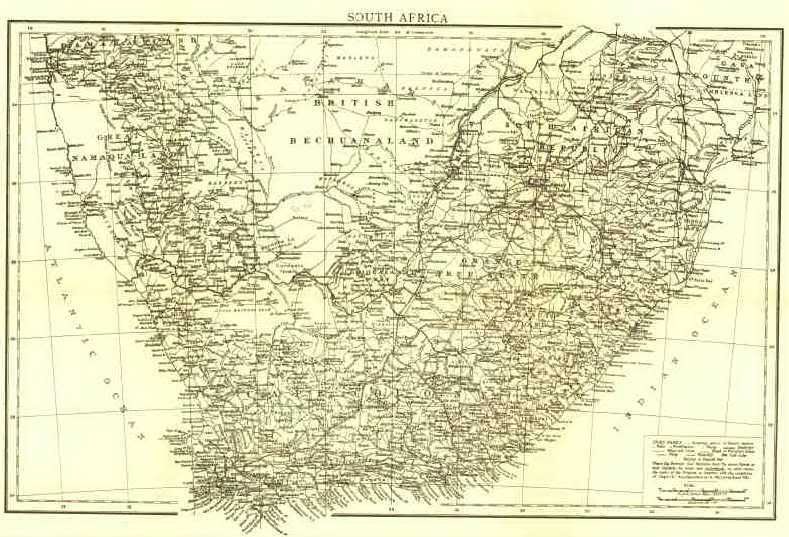The Boer Wars: Part IV
Lines of Communication: Part II
by Capt. Alfred Mahan
The difficulty of reinforcing railway carriage by any other system of road transportation is greatly increased by the local horse-sickness, from which three-fourths of the horses exposed to it die.
Reliance for that purpose, therefore, must be upon the ox-wagon, which for this reason, and owing to the open level character of the country, has in the past played a leading part in the South African migrations.
The main and subsidiary railroads thus summarized should, from the point of view of our subject, be considered as one, contributory to the advance of the British army over a substantially even country, which opposes few natural obstacles to such a movement, though here and there "accidents of the ground -- a range of hills, or a dry river-bed, as at Paardeberg -- may facilitate opposition by a military force.
The system receives no further support until Johannesburg is reached. There the railroad from Durban comes in, and, if its carrying capacity were adequate, which is doubtful, would enable the chief base of operations and main line of communications to be shifted to the nearer locality, retaining the Cape road only as secondary.
The advantage to the British of the line of invasion from Cape Town is that it crosses the mountains, which separate the coast district, from the inland plateau, at such a distance from the enemy's frontier that it is impossible for the latter to offer serious resistance before the comparatively easy rolling country has been reached. It was for this reason that the decision of the Orange Free State to join in the war, while it added to the numerical resistance to be encountered by the British, had for them the compensating advantage that it removed the necessity of forcing their way over the difficult mountain ranges which separate Natal from the Transvaal.
With the power of Great Britain to bring into the field a great superiority of numbers, it is at least open to argument that the Free State, by ceasing to be neutral, relieved the enemy of a difficulty greater than that which its hostility introduced. It was for these reasons that the original British plan, as generally understood, was to make the main invasion along this line.
The danger of Ladysmith, it is commonly and with probability believed, caused the momentary abandonment of this purpose. Whether the change was at the moment correct in principle or not, it is evident that Lord Roberts has reverted to the first intention; a course which enforces its accuracy with all the weight of his well-earned great renown.
The other railroad system of direct importance to the military operations of the present war is the single Natal line, from Durban to Johannesburg and Pretoria, which at Ladysmith throws off a branch to the westward, crossing the mountains to Bethlehem in the Free State, and there ends, over sixty miles from the road between Bloemfontein and Pretoria.
The Natal road, having been opened as lately as 1895, may be considered the child of the Gold Fields; prior to the discovery of which, indeed, there were in the Transvaal neither products nor consumers enough to give commercial value to a railroad.
The Cape Town line reached Pretoria only in 1892, and it is still characteristic of all the lines that there is but little local traffic, either freight or passenger ; the roads exist as means whereby the function of communication, so far discharged by the sea, is prolonged from the coast to the interior of the continent.
It is not the least noteworthy in the incidents of commercial and mechanical energy, by which foreign hands have developed the Transvaal from a poor to a wealthy state, that "all the heavy machinery, the timber, the corrugated iron with which the works and men's houses are constructed, ahd nearly every requirement of work and life, had to be brought for over three hundred miles upon ox- wagons, the country itself supplying scarcely anything, and even to this day (1897) wheat being brought from Australia." (Younghusband's "South Africa of Today." Second Edition, 1899.)
Regarded as a source of supply, especially of military supply, the demands of which are more urgent than those of common life, as its needs and dangers are more imminent, the Natal railroad, though much shorter in distance to the probable scenes of operations, labours under two disadvantages.
The port of Durban is not under all circumstances safe for large vessels to enter, and there is therefore in the facilities for landing goods an inferiority to Cape Town. The country, too, is more difficult, the obstacles to movement, which also favour defence, increasing as the frontier is approached, and culminating on the borders of the Free State and the Transvaal. Being thus nearer, the latter are here better able to concentrate and sustain opposition than they are on the western flank.
by Capt. Alfred Mahan
The difficulty of reinforcing railway carriage by any other system of road transportation is greatly increased by the local horse-sickness, from which three-fourths of the horses exposed to it die.
Reliance for that purpose, therefore, must be upon the ox-wagon, which for this reason, and owing to the open level character of the country, has in the past played a leading part in the South African migrations.
The main and subsidiary railroads thus summarized should, from the point of view of our subject, be considered as one, contributory to the advance of the British army over a substantially even country, which opposes few natural obstacles to such a movement, though here and there "accidents of the ground -- a range of hills, or a dry river-bed, as at Paardeberg -- may facilitate opposition by a military force.
The system receives no further support until Johannesburg is reached. There the railroad from Durban comes in, and, if its carrying capacity were adequate, which is doubtful, would enable the chief base of operations and main line of communications to be shifted to the nearer locality, retaining the Cape road only as secondary.
The advantage to the British of the line of invasion from Cape Town is that it crosses the mountains, which separate the coast district, from the inland plateau, at such a distance from the enemy's frontier that it is impossible for the latter to offer serious resistance before the comparatively easy rolling country has been reached. It was for this reason that the decision of the Orange Free State to join in the war, while it added to the numerical resistance to be encountered by the British, had for them the compensating advantage that it removed the necessity of forcing their way over the difficult mountain ranges which separate Natal from the Transvaal.
With the power of Great Britain to bring into the field a great superiority of numbers, it is at least open to argument that the Free State, by ceasing to be neutral, relieved the enemy of a difficulty greater than that which its hostility introduced. It was for these reasons that the original British plan, as generally understood, was to make the main invasion along this line.
The danger of Ladysmith, it is commonly and with probability believed, caused the momentary abandonment of this purpose. Whether the change was at the moment correct in principle or not, it is evident that Lord Roberts has reverted to the first intention; a course which enforces its accuracy with all the weight of his well-earned great renown.
The other railroad system of direct importance to the military operations of the present war is the single Natal line, from Durban to Johannesburg and Pretoria, which at Ladysmith throws off a branch to the westward, crossing the mountains to Bethlehem in the Free State, and there ends, over sixty miles from the road between Bloemfontein and Pretoria.
The Natal road, having been opened as lately as 1895, may be considered the child of the Gold Fields; prior to the discovery of which, indeed, there were in the Transvaal neither products nor consumers enough to give commercial value to a railroad.
The Cape Town line reached Pretoria only in 1892, and it is still characteristic of all the lines that there is but little local traffic, either freight or passenger ; the roads exist as means whereby the function of communication, so far discharged by the sea, is prolonged from the coast to the interior of the continent.
It is not the least noteworthy in the incidents of commercial and mechanical energy, by which foreign hands have developed the Transvaal from a poor to a wealthy state, that "all the heavy machinery, the timber, the corrugated iron with which the works and men's houses are constructed, ahd nearly every requirement of work and life, had to be brought for over three hundred miles upon ox- wagons, the country itself supplying scarcely anything, and even to this day (1897) wheat being brought from Australia." (Younghusband's "South Africa of Today." Second Edition, 1899.)
Regarded as a source of supply, especially of military supply, the demands of which are more urgent than those of common life, as its needs and dangers are more imminent, the Natal railroad, though much shorter in distance to the probable scenes of operations, labours under two disadvantages.
The port of Durban is not under all circumstances safe for large vessels to enter, and there is therefore in the facilities for landing goods an inferiority to Cape Town. The country, too, is more difficult, the obstacles to movement, which also favour defence, increasing as the frontier is approached, and culminating on the borders of the Free State and the Transvaal. Being thus nearer, the latter are here better able to concentrate and sustain opposition than they are on the western flank.
Labels: The Boer Wars



<< Home